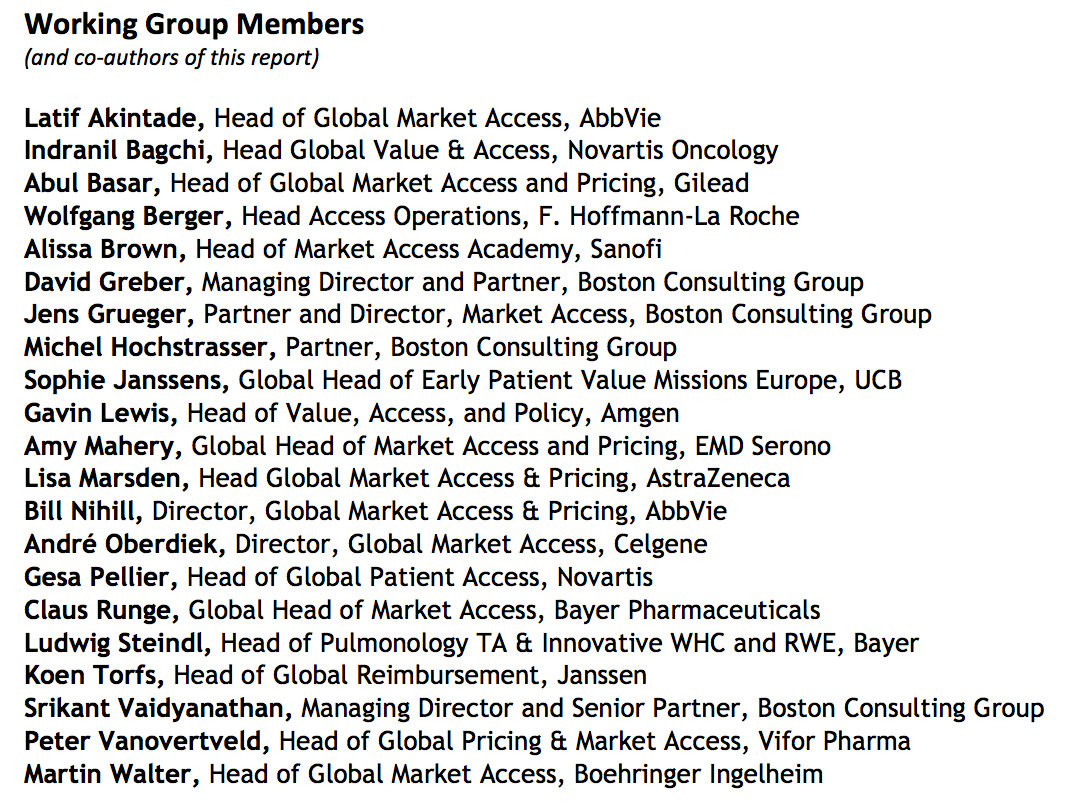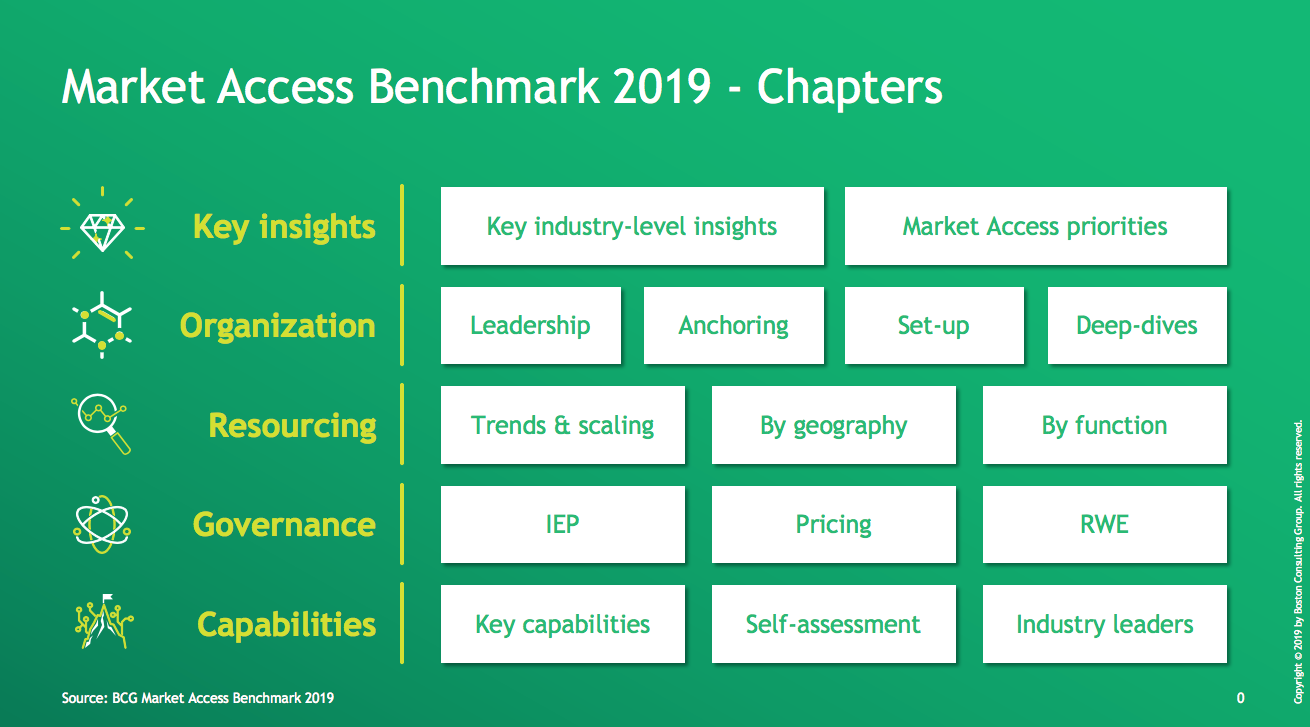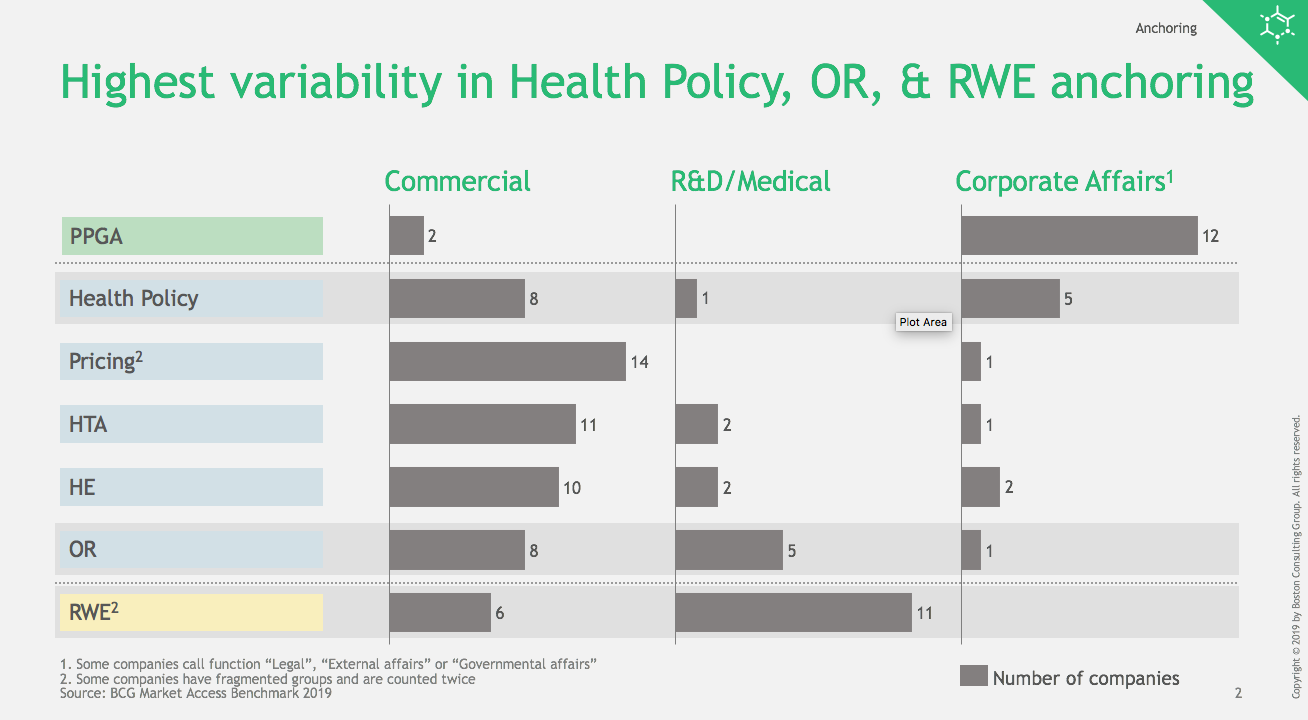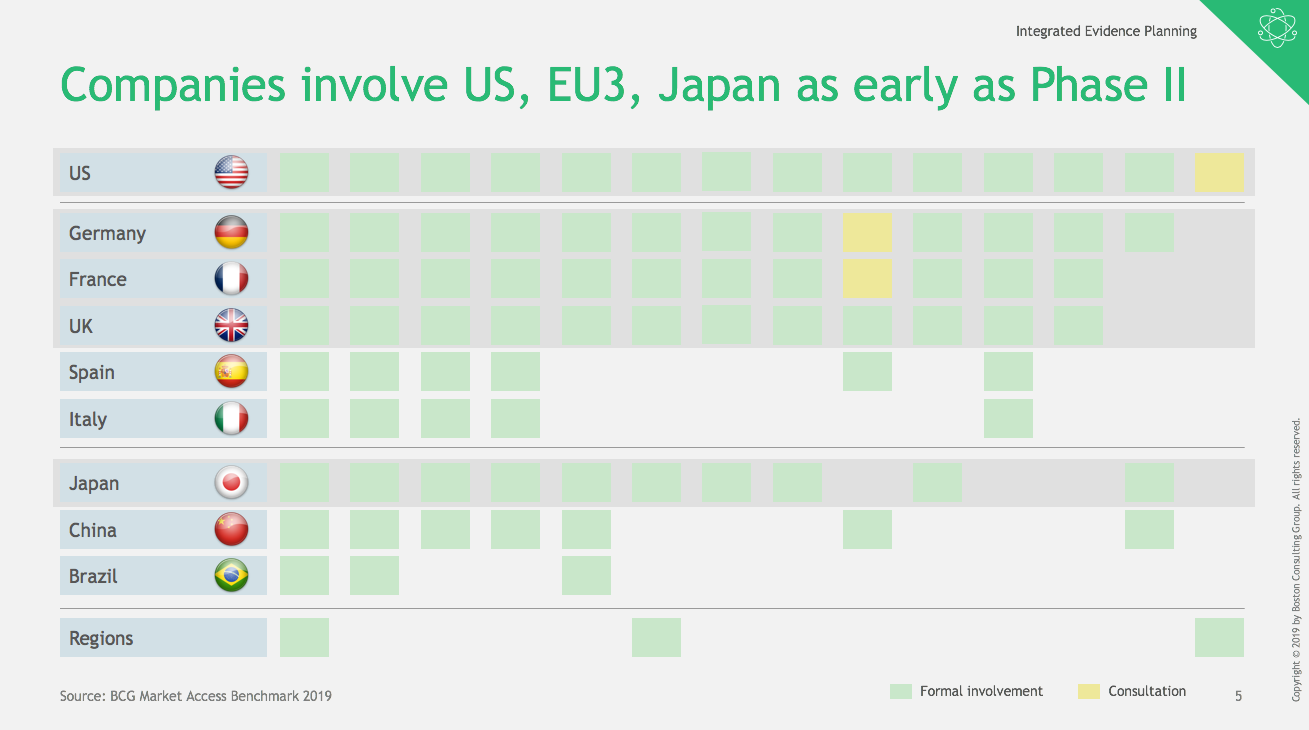Market Access: From Being to Becoming
Key learnings from the BCG Market Access benchmark 2019.
Since 2013, the BCG Market Access Roundtable has been conducting a comprehensive benchmark of Market Access-related activities every three years. In 2019 we conducted our third benchmark which covered the ‘traditional’ Market Access (MA) activities (e.g. pricing, Health Economics (HE), Outcomes Research (OR)), and also activities that interface with other functions, namely health policy and real world evidence (RWE).
Working Group Members; click to enlarge

The 2019 benchmark is based on quantitative data from the 14 participating companies and over 100 interviews conducted with market access, public policy, and RWE leaders from across global, regional and nine local markets: US, EU5, China, Brazil, and Japan. In addition, we ran a structured survey with over 40 questions and synthesized the response of about 400 participants. The detailed results containing over 40 analyses are documented in five chapters: Key insights, Organization, Resourcing, Governance, and Capabilities and shared with the participating companies.
In this publication we highlight key observations from the 2019 benchmark which include 10 industry level insights; deep dives on five hot topics identified, and 10 capabilities that were seen to be critical for the future success of the MA function.
Figure 1. Scope of the 2019 Market Access benchmark

10 industry level insights
- Access function across organizations seem to be in a state of flux with most companies in the benchmark having changed their leadership in the last three years
- Many companies are "experimenting" with alternate models for MA (e.g., BU structures, Agile), based on the approaches the rest of the organization is taking
- Overall anchoring of MA functions is still typically between commercial and R&D, with some shifting in between the two
- 2019 shows fluctuations in resourcing across global, regional and top markets, in contrast to the general overall growth trend observed in 2016
- Role of global versus regional versus local is still largely unresolved with all possible models still in play, and logic deeply embedded in overall organizational anchoring
- Role of Health Policy (separate from Public Policy) has increased across most organizations with many splitting it explicitly from Public Policy and in some cases integrating it within Access Function
- Multiple models co-exist for organizing the RWE function (centralized group, center of excellence (CoE), or decentralized setup) with no clear preferences and continuing shifts
- Importance of Integrated Evidence planning is driving for greater collaboration of MA and Access functions and of global and local with its associated growing pains (e.g., anchoring, local support, funding)
- New technologies (e.g., cell and gene therapies), how to compete in a "data rich world" and "new ways of working" were identified as three trends that would further impact role of Access as a function
- "Understanding of stakeholders that impact MA", "Effective coordination and decision-support within [and beyond] MA functions" and "Ability to optimize strategic pricing objectives" were top ranked capabilities
Deep Dive 1: Market Access priorities
In distilling through the various interviews and survey results we found that a key priority that cuts across all leadership (Market Access, Public Policy and Real World Evidence) groups we talked to was sourcing, developing, and retaining Market Access talent and capabilities.
Figure 2. Market Access priorities

The BCG Market Access Roundtable had already identified talent and capability development as a key priority in its first benchmark in 2013 and based on that work had developed a comprehensive framework on MA competencies.1
Subsequently, the BCG Market Access Roundtable also pioneered the set-up of an executive training course in collaboration with the London School of Economics (which is now in its 3rd year of delivery). Given the fact that this has been highlighted again as a key priority and recognizing that a lot has changed in the last decade, the BCG Market Access Roundtable has launched a new working group to tackle the topic and will provide recommendations by the end of 2020.
Aside from highlighting the need to improve the collaboration across these three sub-functions, six other priorities which fall in the cross-over between two functions was also highlighted and is elucidated in Figure 2.
Deep Dive 2: Organizational anchoring
For our benchmark, we focus on seven key MA activities, five of which are typically within the core of Market Access functions (pricing, health technology assessment (HTA), health economics (HE) , outcomes research (OR) and health policy), and two closely related activities (public policy and government affairs (PPGA), and Real World Evidence (RWE)).
Comparing how the seven key MA activities are anchored across the different companies we identified five key trends that are worth noting:
- Traditional activities: Pricing, HTA, HE and OR are primarily anchored in commercial, while public policy/government affairs is primarily anchored in corporate affairs
- Many of the benchmark companies have started to split out HE and OR and in many of these cases OR is moved to R&D and located/combined with RWE group
- Many companies have started to split out health policy as a specific sub-function from public policy and moved it in with other “traditional” MA activities
- For RWE, while primarily anchored in R&D/medical in most companies, we are seeing a growing trend to split it and have some capacity/capability also in commercial
- Most global MA heads sit at CEO-2 level, often reporting into a Head of Marketing/Strategy/Chief Commercial Officer
Figure 3. Anchoring of Market Access activities

Deep Dive 3: Organizational set-up
We do not observe a dominant organizational design for ‘traditional’ MA activities (e.g. pricing, HEOR), and activities at interface with other functions, namely health policy and RWE. Having said that, we found it helpful to look at two dimensions along which companies have made trade-off choices:
- Degree of centralization vs. de-centralization
- Functional set-up vs. anchoring by therapeutic areas (TA)
Degree of centralization vs. de-centralization: There is a wide spread in the level of centralization versus de-centralization (~1.26x above and below the average) driven by the overall context of the company (e.g. portfolio mix, commercial structures, strategic focus). However, there are two general trends we can observe: a) there is overall tendency to reduce regional/global resourcing in favor of local and b) increasing resources in China.
Figure 4. Two dimensions for organizational trade-off choices

Functional set-up vs. anchoring by therapeutic areas (TA): There is an even higher variation along this dimension driven by distinct choices made by each company to address their specific current challenges. Interviewed MA leaders also made it clear that there was a general expectation that more changes are to come as strategic focus and portfolio/TA mix evolves. In addition, we found that while there is a wide spread in how functional resources are deployed (~1.44x above and below the average), there was a slight overall shift in the functional focus-with increased resources in customer facing activities, in particular those that are local, and gaining efficiency in backend activities like HE/HTA modeling.
Deep Dive 4: Resourcing (Global/Regional/Local)
In the 2016 benchmark, virtually all companies increased their resourcing across the board. In 2019, the picture is more nuanced with some companies continuing to increase their resources (either started later or from a lower base) while others are optimizing existing resource through differentiated deployment. For example, the regional layer is losing favor at about a third of companies. Others are exploring ‘agile’ or ‘new ways of working’ allowing for greater flexibility of resource deployment, which generally also results in fewer regional alignment roles.
As in the other years, we also looked at the overall resourcing of MA function across global, regional and local deployment and found two distinct scaling factors at play:
- The launch needs, expressed by the number of mid to late stage products a company currently has in their pipeline. As MA activity tends to be most pronounced in the lead up to and at launch, the number of mid-late stage products in the pipeline seem to be a good indicator for the MA resource need.
- The overall company size, expressed by the sales of their current products. The value generated from currently marketed products enables companies to hire MA resources, and larger companies by sales can afford to staff greater teams
The scaling by launch needs and sales also allows to control for the differences in TA focus, portfolio, size, and other factors. The close alignment to the regression outlines the validity of the two scaling factors.
Figure 5. Resourcing scaling factors

Deep Dive 5: Integrated Evidence Planning (IEP)
As has been noted in the previous benchmark and continued discussions at the BCG Market Access Roundtable, Integrated Evidence Planning (IEP) has emerged as a key joint process to align evidence generation activities across MA, medical, development, RWE, and regulatory early and across the product life cycle.
Integrating the evidence generation activities ensures the right evidence package is built for a product accounting for all stakeholders in the most effective/efficient way. This requires driving alignment on aspects of target product profile and trial design between functions to ensure right choices are made across functions vs. within a function only.
Most companies have deployed one form or another of IEP, although they are at differing levels of integration, sophistication, and maturity. At earlier stages of integration, companies still develop functional evidence generation plans bottom-up, and bring those plans together into an ‘integrated’ plan later. While this is a good starting basis it does not allow for the most efficient use of resources. In addition, we notice that involvement of countries (timing and number) varies across the companies and is less systematic in terms of the involvement of smaller yet progressive countries.
Figure 6. Countries and regions involved in Integrated Evidence Planning (IEP)

10 top capabilities to ensure future success
Close to 400 MA colleagues from global, region, and the nine largest countries outlined what they perceive to be the key capabilities for future success. Ten capabilities stood out, covering “traditional” aspects of MA such as health policy, evidence generation and synthesis, pricing, as well as broader themes such as organizational effectiveness (Figure 7).
Figure 7. Top 10 capabilities for future success in Market Access

Looking across the top 10 capabilities, two key themes emerge: Evidence generation and synthesis, and collaboration/co-creation.
More than half the capabilities relate to collaborating and co-creating with both internal and external stakeholders. As MA is becoming even more of a cross-functional endeavor, more MA objectives can only be achieved through support and collaboration from other functions. Consequently, the ability to steer the whole organization towards achieving MA goals becomes more complex. Hence more capabilities in this regards are required.
Outlook
With access becoming the front and center issue for pharma companies, “Access” is part of the agenda of multiple different functions, and the role of the MA function is evolving rapidly.
With the increased importance comes a greater need to more closely collaborate with other functions and drive the larger organization towards achieving the company’s Access objectives. At the same time, other functions are building their Access focus and capabilities. Hence Access activities are no longer limited to the MA function only, and while the reach of Access is increasing, the remit of the MA function is blurring.
The MA function will need to refine their focus and rethink the way they interact with internal (and external) counterparts and stakeholders.
In a subsequent publication, the BCG Market Access Roundtable will explore further how the role of Access is evolving, and provide a perspective of how Market Access functions will need to set themselves up differently to succeed going forward.
Reference
1. Published earlier, http://www.pharmexec.com/building-market-access-competencies-future
Beyond the Prescription: Pharma's Role in Digital Health Conversations
April 1st 2025Join us for an insightful conversation with Jennifer Harakal, Head of Regulatory Affairs at Canopy Life Sciences, as we unpack the evolving intersection of social media and healthcare decisions. Discover how pharmaceutical companies can navigate regulatory challenges while meaningfully engaging with consumers in digital spaces. Jennifer shares expert strategies for responsible marketing, working with influencers, and creating educational content that bridges the gap between patients and healthcare providers. A must-listen for pharma marketers looking to build trust and compliance in today's social media landscape.
Beyond the Prescription: The Role Pharma Plays in Digital Health Conversations
April 1st 2025As social media continues to influence healthcare communication, it presents both challenges and opportunities for the pharmaceutical industry. In this interview, Jennifer Harakal of Canopy Life Sciences discusses balancing compliance with effective digital engagement to build trust and facilitate meaningful healthcare conversations.